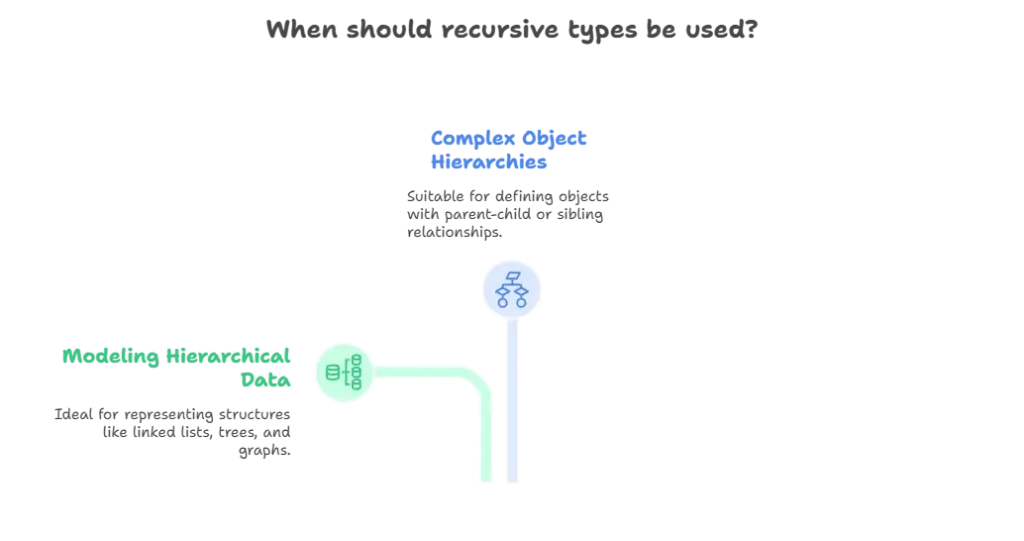Recursive Types
TypeScript's recursive types allow you to define types that refer to themselves. This is particularly useful for modeling data structures that have a hierarchical or nested nature, such as linked lists, trees, and complex object hierarchies. This chapter delves into the world of recursive types, exploring the fundamentals, advanced usages, and best practices for effectively utilizing them in your code.
Basic Recursive Types
Self-Referential Type Definitions
A recursive type definition allows a type to reference itself within its structure. This creates a type that can represent a sequence of nested elements of the same type.
type LinkedList<T> = {
value: T;
next?: LinkedList<T>; // Next element can be of the same LinkedList type
};
const numberList: LinkedList<number> = {
value: 1,
next: {
value: 2,
next: {
value: 3,
next: undefined // End of the linked list
}
}
};
console.log(numberList.value); // Output: 1
console.log(numberList.next!.value); // Output: 2 (using non-null assertion)
console.log(numberList.next!.next!.value); // Output: 3
Accessing Nested Elements
Since the next property can be another LinkedList of the same type, you can traverse the linked list by accessing nested elements. In this example, we use non-null assertions (!) to ensure we’re accessing valid properties at each level.
Recursive Interfaces
Defining Interface Structures with Self-Reference
Interfaces, similar to types, can leverage recursion to define structures that contain properties referring back to the interface itself.
interface TreeNode<T> {
value: T;
children?: TreeNode<T>[]; // Children can be an array of the same TreeNode type
}
const tree: TreeNode<string> = {
value: "Root",
children: [
{ value: "Child 1", children: [] },
{
value: "Child 2",
children: [
{ value: "Grandchild 1", children: [] },
{ value: "Grandchild 2", children: [] }
]
}
]
};
console.log(tree.value); // Output: "Root"
console.log(tree.children![0].value); // Output: "Child 1"
console.log(tree.children![1].children![1].value); // Output: "Grandchild 2" (accessing nested child)
Representing Hierarchical Data
Recursive interfaces are perfect for representing hierarchical data structures like trees, where nodes can have child nodes of the same type, creating a parent-child relationship.
Conditional Recursive Types
Defining Types Based on Conditions
TypeScript allows you to define recursive types with conditions. This enables creating more complex structures where the type of the next element or child node can vary based on specific criteria.
type StackFrame<T> = {
value: T;
next?: T extends string ? StackFrame<string> : never; // Next can only be string if current value is string
};
const stringStack: StackFrame<string> = {
value: "Item 1",
next: { value: "Item 2", next: undefined }
};
// Error: next property can only be of type StackFrame<string> for string values
const numberStack: StackFrame<number> = {
value: 10,
next: { value: 20 } // Type mismatch
};
Enhancing Type Safety with Conditions
Conditional recursive types add another layer of type safety by restricting the type of the next element or child node based on the current element’s type. This helps prevent runtime errors and improves code reliability.
Advanced Recursive Types
Nested Recursive Structures
You can combine recursive types to create even more complex structures. For example, a binary search tree could have left and right child nodes that are themselves TreeNode types.
interface BinaryTreeNode<T> {
value: T;
left?: BinaryTreeNode<T>;
right?: BinaryTreeNode<T>;
}
// Example usage of BinaryTreeNode for a binary search tree (omitted for brevity)
type GraphNode<T> = {
value: T;
neighbors?: GraphNode<T>[]; // Neighbors can be an array of the same GraphNode type with generic T
};
const stringGraph: GraphNode<string> = {
value: "Node A",
neighbors: [
{ value: "Node B" },
{ value: "Node C" }
]
};
const numberGraph: GraphNode<number> = {
value: 10,
neighbors: [
{ value: 20 },
{ value: 30 }
]
};
// Both stringGraph and numberGraph can be used with type safety for their respective data types
Generic Constraints for Recursive Types
When using generics with recursive types, you can apply constraints to the generic type parameter. This ensures the type used with the recursive structure meets specific requirements.
type Comparable<T> = {
value: T;
compareTo(other: Comparable<T>): number; // Constraint: requires a compareTo method
};
type BinarySearchTree<T extends Comparable<T>> = { // Generic with constraint
value: T;
left?: BinarySearchTree<T>;
right?: BinarySearchTree<T>;
};
// Now BinarySearchTree can only be used with types that have a compareTo method
When to Use Recursive Types
Modeling Hierarchical Data
Recursive types are ideal for representing hierarchical data structures with nested elements of the same type. Examples include linked lists, trees, and graphs.
Complex Object Hierarchies
Recursive types can be used to define complex object hierarchies where objects can contain references to other objects of the same type, creating parent-child or sibling relationships.

Best Practices for Recursive Types
- Clarity and Documentation: Clearly name your recursive types and interfaces to improve code readability. Consider adding comments to explain the purpose and usage of the recursive structure.
- Base Case: Ensure a clear base case in your recursive definition to prevent infinite loops. This typically involves a condition where the recursion stops and a terminal type is reached (e.g.,
undefinedor a non-recursive type). - Testing: Thoroughly test your code using various data structures built with your recursive types to ensure they function as expected and handle edge cases appropriately.
- Consider Alternatives: Evaluate if traditional non-recursive approaches can achieve the desired outcome for simpler cases. Recursive types can add complexity, so use them judiciously.
Key Points
- Utility Types: Explore utility types like
Partial,Readonly, andPickto manipulate recursive structures for specific use cases. - Advanced Generics: Delve into advanced generics concepts like mapped types and conditional types to further enhance the flexibility and type safety of your recursive structures.
Recursive types provide a powerful tool for modeling complex data structures and object hierarchies in TypeScript. By understanding their concepts, limitations, and best practices, you can leverage them effectively to write well-structured and type-safe code for various scenarios. Remember, use them strategically and prioritize clarity when simpler solutions exist. Happy coding !❤️
